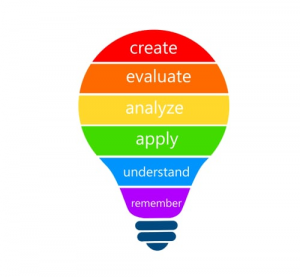
Bloom’s Taxonomy & technology: keeping students engaged
Bloom’s Taxonomy remains one of the most reliable and timeless approaches to classroom engagement and recall. It’s so classic, it’s been immune to the otherwise ubiquitous education acronyms. In fact, Bloom’s has quietly led the critical thinking approach, now branded New Education, with learning objectives in cognitive, affective and sensory domains.
Bloom’s first emerged in 1956, Taxonomy of Educational Objectives (Handbook One). In the 2000s, revisions were made to simplify language and make the concepts easier to describe. Without an acronym of its own, Bloom’s throws its weight behind a big one: PBL, or Project Based Learning. Using Bloom’s, you can lead students from introduction through analysis to generating something new based on their synthesis of the material. Lessons can be modified to integrate technology when appropriate, as noted below.

Remember
Exhibit memory of previously learned material by recalling facts, terms, basic concepts and answers.
- Make a timeline of events.
- List all the characters, dates or other categories in the story/article/reading piece.
- Write a list of any pieces of information you can remember.
Tech tip: If you’ve read the material in an ebook, export your notes and highlights to Google Drive.
Understand
Demonstrate understanding of facts and ideas by organizing, comparing, translating, interpreting, giving descriptions and stating main ideas.
- Illustrate what you think the main idea was.
- Prepare a flowchart to illustrate the sequence of events.
- Make a comic strip showing the sequence of events.
Tech tip: Comic Life is one of many great apps to try.
Apply
Solve problems to new situations by applying acquired knowledge, facts, techniques and rules in a different way.
- Make up a puzzle game using the ideas from the study area.
- Write a textbook or zine for others.
Tech tip: Upload to your school’s Local Content to share with your community.
- Paint a mural using the same materials.
Tech tip: Use a digital drawing or paint app; have each student add a new piece of visual information.
Analyze
Examine and break information into parts by identifying motives or causes. Make inferences and find evidence to support generalizations.
- Design a questionnaire to gather information.
- Make a family tree showing relationships.
- Construct a mind map, a visual representation of ideas.
Tech tip: Check out MindNode for a digital way to brainstorm, organize and share your mind maps.
Evaluate
Present and defend opinions by making judgments about information, validity of ideas or quality of work based on a set of criteria.
- Conduct a debate about an issue in the reading.
- Make a booklet about 5 rules you see as important. Convince others.
- Form a panel to discuss differing views.
Tech tip: Invite experts or outside speakers to join via Skype.
Create
Compile information together in a different way by combining elements in a new pattern or proposing alternative solutions.
- Invent a machine to do a specific task.
- Create a new product. Give it a name and plan a marketing campaign.
- Design a record, book or magazine cover.
Tech tip: Create a digital gallery for the smartboard or another screen in the school building.
Image source: APASS Educational Group
Browse blog and media articles
Public Library Training
K-12 Library Training